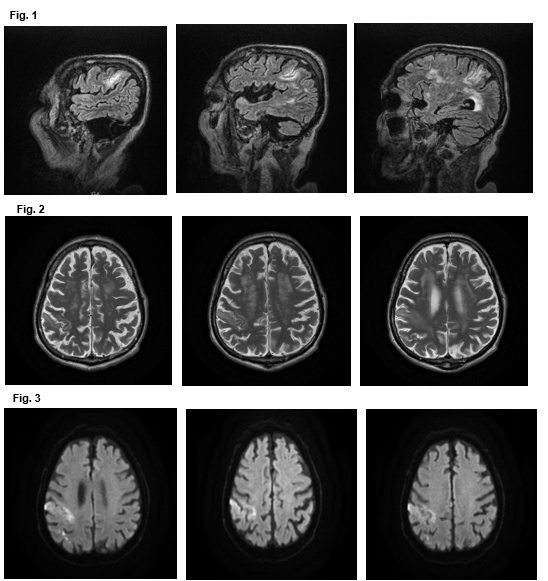Category: Other
Objective: This case is presented to create awareness of this interesting clinical scenario, which can be terrifying to the patients and confusing to the physicians who are not aware of it.
Background: An alien limb (also known as anarchic hand sign ) most usually the arm but sometimes the leg, is the one that manifests slow, involuntary, levitating, quasi-purposive movements. These phenomena are often associated with a prominent grasp reflex, forced groping, intermanual conflict, and magnetic movements of the hand (1).
Method: Hereby we would like to present the case of a 86 years-old male with known medical history of Diabetes mellitus type II, Aortic aneurysm without a prescribed treatment who was admitted in our Outpatient Department with complaint of observing his left hand moving without his knowledge. His attempts to control the left hand with the right hand were unsuccessful. He did not have any control of the left hand.
Results: MRI of the brain showed a lesion with restricted diffusion suggestive for an ischemic stroke in right parietal lobe.
For secondary stroke prevention, aimed at reducing the risk of another stroke the optimal treatment of vascular risk factors and the administration of antiplatelet therapy have been started.
On the next examination it was observe an important improvement of controlling his left-hand movements.
Axial and sagittal images demonstrate:
Diffusion -weighted axial image reveals an area of restricted diffusion in the territory of the right middle cerebral artery (MCA, central and postcentral gyrus)
Sagittal FLAIR and axial T2 images show hyperintensity of the right parietal lobe
Chronic ischemic leukoencephalopathy with periventricular predominance in T2 and FLAIR images
Conclusion: Our patient developed the alien hand syndrome in the left (nondominant) hand following an ischemic stroke of the right parietal lobe (including central and postcentral gyrus) due to an occlusion of the terminal branch of right middle cerebral artery.
Alien hand syndrome as the presentation of stroke is extremely rare but can be terrifying to patients (2).
The etiology includes after surgery on the corpus callosum, tumor, aneurysms, degenerative diseases of the brain, and uncommonly stroke (2).
Lesions implicated in causing alien hand syndrome include those in the corpus callosum and/or posterior parietal cortex, supplementary motor area and the anterior cingulate cortex.
References: 1. Fisher CM. Alien hand phenomena: a review with the addition of six personal cases. Canadian Journal of Neurological Sciences 2000; 27: 192–203. 2. Doody RS, Jankovic J. The alien hand and related signs. J Neurol Neurosurg Psychiatry. 1992;55(9):806–810. 3. Sarah Barbara Elisa Debray, Jelle Demeestere. Alien Hand Syndrome. American Academy of Neurology. First published September 10, 2018.
To cite this abstract in AMA style:
A. Balan, I. Buraga. The alien hand syndrome [abstract]. Mov Disord. 2021; 36 (suppl 1). https://www.mdsabstracts.org/abstract/the-alien-hand-syndrome/. Accessed November 21, 2025.« Back to MDS Virtual Congress 2021
MDS Abstracts - https://www.mdsabstracts.org/abstract/the-alien-hand-syndrome/

